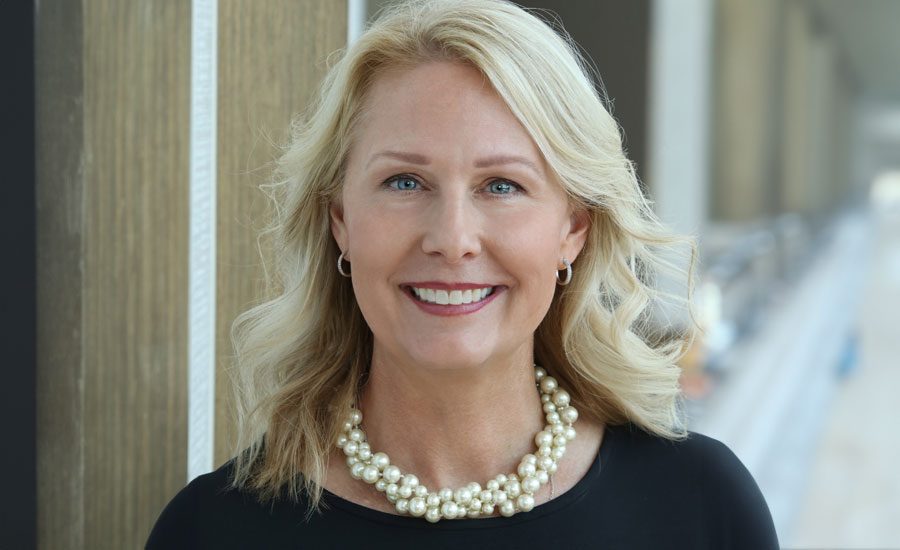
Roofing contractor Texas Roof Management Inc.
faced a wide variety of challenges on the award-winning Mosaic project in Dallas. Photo courtesy
of GAF Materials Corporation, Wayne,
N.J.
One of Dallas’ most striking high-rise residential communities, the Mosaic represents today’s modern urban lifestyle like few other buildings.
Its roof is also an award-winning composite of roofing technologies that looks more like artwork than a roofing membrane. This creative addition to the Dallas skyline continues to impress residents and visitors alike.
The Mosaic project involved the 2007 renovation of the former Fidelity Union Bank and Insurance complex - two aging vacant downtown Dallas office towers - by Hamilton Properties Corporation. The 35,000 square foot roof renovation earned contractor Texas Roof Management Inc. (TRMI) the 2007 Golden Hammer Award from the North Texas Roofing Contractors Association.
The group awarded TRMI its Outstanding Commercial Roofing Project for a job that was riddled with challenges, including poor access between the 15 different roof levels situated between the building’s two towers. Also, many of the roof perimeters included only a gravel guard edge, beyond which was a drop-off of 230 to 410 feet to street level. All roofs required removal of up to four layers of existing roofing containing asbestos, coal tar pitch and fiberglass insulation. In addition, inadequate drainage and severe ponding water existed on every roof level.
“The Mosaic remains a memorable project for our company not only because of the landmark that it has become in the City of Dallas, but also because of the collaborative efforts of the building owner, the roof manufacturer and our crews and project managers,” said Catherine Awtrey, president of TRMI. “The complexity of working on 15 different roof levels, while still creating beautiful artwork, including the ‘mosaic’ logo displayed on the highest roof level, was challenging and most rewarding. Together, we all diligently worked to create a long lasting impression on the Dallas skyline.”
Safety precautions included perimeter fall protection consisting of steel cabling with flags mounted to the structure. All workers outside of the fall protection were tied off with lanyards and safety lines to tie back, and a second lifeline to a different tie back.
Despite these job complexities, the Mosaic project was completed on time, within budget and with no punch list items, according to Awtrey. “Since its completion, there have been no leak calls or any other issues relative to the roof itself or the installation. The occupancy rate at the Mosaic currently is 80 percent, a very good number considering the difficult economic times we are experiencing.”
GAF Materials Corporation supplied the materials for the Mosaic roof, which included 1.5 inches to 7 inches of EnergyGuard Tapered ISO; Liberty SBS Self-adhering Base Sheet; Ruberoid SBS Heatweld 25; and Ruberoid Torch FR. The adhesive used on the roof was OLYBOND 500/Spot Shot by OMG Roofing Products, Agawam, Mass. The three-ply modified bitumen system is covered by a 20-year warranty.
“The specification was unique and resulted in an extremely durable roof,” said GAF’s Jim McNeel, director of low slope sales, Southwestern region, in Dallas. “Because the Southwest uses mostly white reflective cap sheets, the Ruberoid Torch FR was difficult to find in black. But because GAF is supported by national located distribution, we found a Midwest location with the material in stock.”
“Without question, the GAF team was extremely instrumental in completing this very complex project,” added Awtrey. “From beginning to end, GAF provided the support when needed.”
Three years later, TRMI continues to be a strong proponent of self-adhered and cold-process modified bitumen roof systems. The use of self-adhering membranes in traditional systems is growing in popularity, especially on jobs where pumping up bulk asphalt is a challenge.
“We use these systems as frequently as possible,” says Awtrey. “They are clean and environmentally friendly.”


